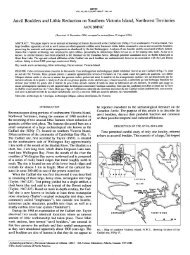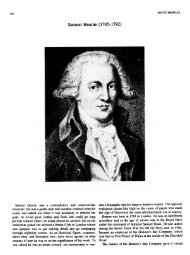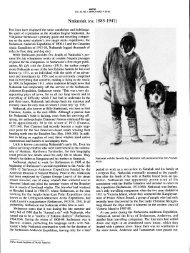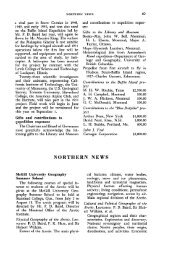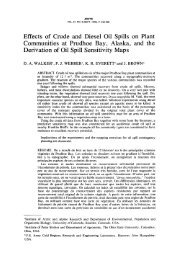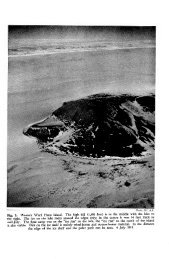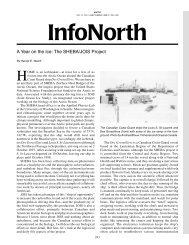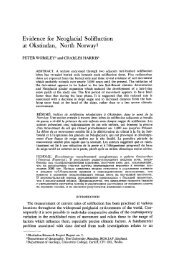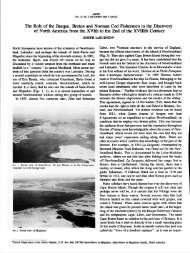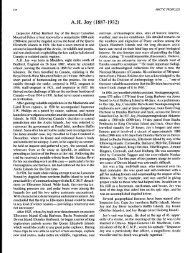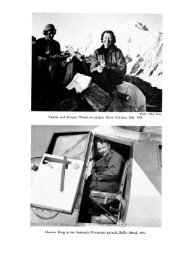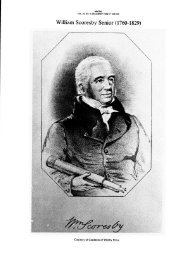Freeze-thaw effect on consolidation properties of fine grained soils ...
Freeze-thaw effect on consolidation properties of fine grained soils ...
Freeze-thaw effect on consolidation properties of fine grained soils ...
Create successful ePaper yourself
Turn your PDF publications into a flip-book with our unique Google optimized e-Paper software.
<str<strong>on</strong>g>Freeze</str<strong>on</strong>g>-<str<strong>on</strong>g>thaw</str<strong>on</strong>g> <str<strong>on</strong>g>effect</str<strong>on</strong>g> <strong>on</strong> c<strong>on</strong>solidati<strong>on</strong><br />
<strong>properties</strong> <strong>of</strong> <strong>fine</strong> <strong>grained</strong> <strong>soils</strong> from the<br />
Mackenzie valley, Canada<br />
Bhuwani Paudel<br />
Trow Associates Inc., Ottawa, Ontario, Canada (formally Natural Resources Canada)<br />
Baolin Wang<br />
Natural Resources Canada, Ottawa, Ontario, Canada<br />
ABSTRACT<br />
This paper presents laboratory test results <strong>of</strong> freeze-<str<strong>on</strong>g>thaw</str<strong>on</strong>g> <str<strong>on</strong>g>effect</str<strong>on</strong>g> <strong>on</strong> c<strong>on</strong>solidati<strong>on</strong> <strong>properties</strong> <strong>of</strong> <strong>fine</strong> <strong>grained</strong> <strong>soils</strong> from<br />
the Mackenzie valley, Canada. Soil samples were collected from two landslide sites in the Mackenzie valley. The<br />
samples were obtained from the bottom <strong>of</strong> the active layer at about 1 m depth below ground surface. A total <strong>of</strong> 32<br />
remoulded samples were prepared with varying water c<strong>on</strong>tents to reflect the moisture c<strong>on</strong>diti<strong>on</strong>s in the active layer and<br />
near the permafrost table. The samples were tested for coefficient <strong>of</strong> c<strong>on</strong>solidati<strong>on</strong> and hydraulic c<strong>on</strong>ductivity after 0, 3,<br />
5 and 10 cycles <strong>of</strong> freezing and <str<strong>on</strong>g>thaw</str<strong>on</strong>g>ing. The coefficient <strong>of</strong> c<strong>on</strong>solidati<strong>on</strong> increased by an order <strong>of</strong> magnitude and<br />
hydraulic c<strong>on</strong>ductivity by <strong>on</strong>e to two orders <strong>of</strong> magnitude after freezing and <str<strong>on</strong>g>thaw</str<strong>on</strong>g>ing. These <strong>properties</strong> c<strong>on</strong>tinue to<br />
increase with the increase <strong>of</strong> the number <strong>of</strong> freeze-<str<strong>on</strong>g>thaw</str<strong>on</strong>g> cycles, but at a much slower rate.<br />
RÉSUMÉ<br />
Cet article présente une étude en laboratoire de l'effet de gel-dégel sur les propriétés de c<strong>on</strong>solidati<strong>on</strong> de sols à texture<br />
<strong>fine</strong> de la vallée du Mackenzie, au Canada. Des échantill<strong>on</strong>s de sol <strong>on</strong>t été prélevés dans deux sites de glissements de<br />
terrain dans la vallée du Mackenzie. Les échantill<strong>on</strong>s <strong>on</strong>t été obtenus à partir du bas de la couche active à envir<strong>on</strong> 1 m<br />
de pr<strong>of</strong><strong>on</strong>deur. Un total de 32 échantill<strong>on</strong>s de sol remanié <strong>on</strong>t été préparés avec différentes teneurs en eau afin de<br />
refléter les c<strong>on</strong>diti<strong>on</strong>s d'humidité dans la couche active et près du pergélisol. Les échantill<strong>on</strong>s <strong>on</strong>t été testés pour le<br />
coefficient de c<strong>on</strong>solidati<strong>on</strong> et la c<strong>on</strong>ductivité hydraulique après 0, 3, 5 et 10 cycles de gel et de dégel. Le coefficient de<br />
c<strong>on</strong>solidati<strong>on</strong> a augmenté d’un ordre de grandeur après c<strong>on</strong>gélati<strong>on</strong> et déc<strong>on</strong>gélati<strong>on</strong>. La c<strong>on</strong>ductivité hydraulique a<br />
augmenté d’un à deux ordres de grandeur après c<strong>on</strong>gélati<strong>on</strong> et déc<strong>on</strong>gélati<strong>on</strong>. Les coefficients c<strong>on</strong>tinuent à augmenter<br />
avec l'augmentati<strong>on</strong> du nombre de cycles de gel-dégel, mais à un rythme beaucoup plus lent.<br />
1 INTRODUCTION<br />
Coefficient <strong>of</strong> c<strong>on</strong>solidati<strong>on</strong> and hydraulic c<strong>on</strong>ductivity<br />
are important engineering <strong>properties</strong> <strong>of</strong> <strong>fine</strong> <strong>grained</strong> <strong>soils</strong>.<br />
The <strong>properties</strong> have critical <str<strong>on</strong>g>effect</str<strong>on</strong>g>s <strong>on</strong> excess pore water<br />
pressure and ground settlement during <str<strong>on</strong>g>thaw</str<strong>on</strong>g>ing <strong>of</strong> frozen<br />
<strong>soils</strong> (Morgenstern and Nix<strong>on</strong>, 1971). Freezing and<br />
<str<strong>on</strong>g>thaw</str<strong>on</strong>g>ing process severely affects those <strong>properties</strong> <strong>of</strong> <strong>fine</strong><br />
<strong>grained</strong> <strong>soils</strong> (Chamberland and Gow, 1979; Graham<br />
and Au, 1985; Viklandar, 1998; K<strong>on</strong>rad and Sams<strong>on</strong>,<br />
2000; Qi et al., 2006; Hui and Ping, 2009). Chamberland<br />
and Gow (1979) reported that hydraulic c<strong>on</strong>ductivity <strong>of</strong><br />
<strong>fine</strong> <strong>grained</strong> <strong>soils</strong> increases with increase <strong>of</strong> the number<br />
<strong>of</strong> freeze-<str<strong>on</strong>g>thaw</str<strong>on</strong>g> cycles. Qi et al. (2006) studied the <str<strong>on</strong>g>effect</str<strong>on</strong>g><br />
<strong>of</strong> <strong>on</strong>e freeze-<str<strong>on</strong>g>thaw</str<strong>on</strong>g> cycle with different freezing<br />
temperature and dry unit weight <strong>of</strong> <strong>fine</strong> <strong>grained</strong> <strong>soils</strong>.<br />
They proposed a critical dry unit weight. Soil strength<br />
parameters either decrease or increase if dry unit weight<br />
is higher or lower than the critical dry unit weight before<br />
freezing. Viklandar (1998) proposed a critical void ratio<br />
after repeated freezing and <str<strong>on</strong>g>thaw</str<strong>on</strong>g>ing <strong>of</strong> <strong>fine</strong> <strong>grained</strong> <strong>soils</strong>.<br />
Graham and Au (1985) studied freeze-<str<strong>on</strong>g>thaw</str<strong>on</strong>g> <str<strong>on</strong>g>effect</str<strong>on</strong>g> <strong>on</strong><br />
natural clay and observed that freezing and <str<strong>on</strong>g>thaw</str<strong>on</strong>g>ing<br />
cause increase in compressibility and pore water<br />
pressure and decrease in strength at low stress.<br />
992<br />
Although some studies have been d<strong>on</strong>e <strong>on</strong> those soil<br />
<strong>properties</strong> as noted above, few research works have<br />
been found about the freeze-<str<strong>on</strong>g>thaw</str<strong>on</strong>g> <str<strong>on</strong>g>effect</str<strong>on</strong>g> <strong>on</strong> soil<br />
coefficient <strong>of</strong> c<strong>on</strong>solidati<strong>on</strong> (Cv). Paudel and Wang<br />
(2009) summarized some data reported in the literature<br />
about Cv values <strong>of</strong> <strong>fine</strong> <strong>grained</strong> <strong>soils</strong> from permafrost<br />
regi<strong>on</strong>s. The paper reported test results <strong>of</strong> Cv values for a<br />
number <strong>of</strong> typical soil samples from the Mackenzie<br />
valley, Northwest Territories in Canada. However, the<br />
tests were focused <strong>on</strong> existing c<strong>on</strong>diti<strong>on</strong>s <strong>of</strong> the <strong>soils</strong>.<br />
Given the importance <strong>of</strong> this parameter to engineering<br />
design and analysis for northern projects, a new test<br />
program was carried out to further extend the study to<br />
investigate the freeze-<str<strong>on</strong>g>thaw</str<strong>on</strong>g> <str<strong>on</strong>g>effect</str<strong>on</strong>g> <strong>on</strong> c<strong>on</strong>solidati<strong>on</strong><br />
<strong>properties</strong> <strong>of</strong> such <strong>soils</strong>. This paper summarizes the test<br />
program and the results.<br />
2 SOIL SAMPLING AND TESTING<br />
Soil samples were collected from two sites in the<br />
Mackenzie valley, as shown in Figure 1, where I denotes<br />
the site in Inuvialuit settlement regi<strong>on</strong> and G denotes the<br />
site in Gwich’in settlement regi<strong>on</strong>. Samples were<br />
recovered from the bottom <strong>of</strong> the active layer at depth <strong>of</strong><br />
about 1 m from the ground surface. Typical soil
gradati<strong>on</strong>s for the southern (G) and northern (I) regi<strong>on</strong>s<br />
are given in Figure 2. The <strong>soils</strong> from the southern site (G)<br />
are <strong>fine</strong>r than that from the northern site (I). Atterberg<br />
Limits <strong>of</strong> these samples are given in Table 1. The<br />
samples from the southern G site show higher plasticity<br />
than those from the northern I site.<br />
Figure 1. Map showing soil sample locati<strong>on</strong>s in (G)<br />
Gwich’in settlement regi<strong>on</strong> and in (I) Inuvialuit settlement<br />
regi<strong>on</strong><br />
Percent Finer (%)<br />
100<br />
90<br />
80<br />
70<br />
60<br />
Grain Size Distributi<strong>on</strong> (ASTM Classificati<strong>on</strong>)<br />
Clay Silt Sand<br />
50<br />
G1<br />
40<br />
G2<br />
G5<br />
30<br />
G9<br />
20<br />
I1<br />
10<br />
0<br />
I2<br />
I3<br />
0.001 0.01 0.1<br />
Grain Size (mm)<br />
1 10<br />
Figure 2. Grain size distributi<strong>on</strong> for samples from I and G<br />
regi<strong>on</strong>s<br />
Table 1. Index <strong>properties</strong> <strong>of</strong> soil samples<br />
Samples Liquid<br />
Limit<br />
Plastic<br />
Limit<br />
Plasticity<br />
Index<br />
(%) (%) (%)<br />
I Site 36 13 23<br />
G Site 62 26 36<br />
993<br />
Soils subject to repeated freezing and <str<strong>on</strong>g>thaw</str<strong>on</strong>g>ing<br />
usually exhibit various levels <strong>of</strong> moisture c<strong>on</strong>diti<strong>on</strong><br />
depending <strong>on</strong> the elevati<strong>on</strong> relative to the permafrost<br />
table. Normally, the closer to permafrost table, the higher<br />
<strong>of</strong> the moisture c<strong>on</strong>tent (Wang et al, 2008). In order to<br />
investigate freeze-<str<strong>on</strong>g>thaw</str<strong>on</strong>g> <str<strong>on</strong>g>effect</str<strong>on</strong>g> <strong>on</strong> <strong>soils</strong> <strong>of</strong> different<br />
moisture c<strong>on</strong>diti<strong>on</strong>s, specimens were prepared by mixing<br />
the samples to have water c<strong>on</strong>tents <strong>of</strong> 30, 35, 40 and<br />
45%, which are representative <strong>of</strong> the in-situ moisture<br />
c<strong>on</strong>diti<strong>on</strong>s measured at the sites (Wang et al, 2008).<br />
C<strong>on</strong>venti<strong>on</strong>al sized odometer (c<strong>on</strong>solidometer) <strong>of</strong> 64<br />
mm diameter and 25 mm in height was used for the test.<br />
However, instead <strong>of</strong> using c<strong>on</strong>venti<strong>on</strong>al steel odometer<br />
ring, special plastic rings were used for this test. The<br />
plastic rings were fabricated from Delrin 100 AF 13%<br />
Tefl<strong>on</strong> material. The use <strong>of</strong> the plastic material was to<br />
reduce the lateral heat c<strong>on</strong>ducti<strong>on</strong> during freezing and<br />
<str<strong>on</strong>g>thaw</str<strong>on</strong>g>ing.<br />
The prepared soil specimen was put in the odometer<br />
ring sitting <strong>on</strong> a glass plate. Styr<strong>of</strong>oam was installed<br />
around the odometer ring to limit lateral heat c<strong>on</strong>ducti<strong>on</strong><br />
during freezing and <str<strong>on</strong>g>thaw</str<strong>on</strong>g>ing. The soil-ring-styr<strong>of</strong>oam<br />
assembly was sealed in a plastic bag to minimize<br />
moisture loss (Figure 3).<br />
Figure 3. Sample assembly with insulati<strong>on</strong> for <strong>on</strong>edimensi<strong>on</strong>al<br />
freezing and <str<strong>on</strong>g>thaw</str<strong>on</strong>g>ing<br />
The sealed specimen assembly was kept in a cold<br />
room at -10ºC to -12ºC for 24 hours for each freeze<br />
cycle. It was then taken out <strong>of</strong> the cold room and<br />
exposed to room temperatures for 24 hours to complete<br />
a freeze-<str<strong>on</strong>g>thaw</str<strong>on</strong>g> cycle. The specimens were subject to 0, 3,<br />
5 or 10 freeze-<str<strong>on</strong>g>thaw</str<strong>on</strong>g> cycles. A total <strong>of</strong> 32 assemblies were<br />
made for the test program (2 sites x 4 moisture c<strong>on</strong>tents<br />
x 4 freeze-<str<strong>on</strong>g>thaw</str<strong>on</strong>g> cycles).<br />
C<strong>on</strong>venti<strong>on</strong>al c<strong>on</strong>solidati<strong>on</strong> tests were carried out at<br />
room temperatures after the samples have underg<strong>on</strong>e<br />
the desired number <strong>of</strong> freeze-<str<strong>on</strong>g>thaw</str<strong>on</strong>g> cycles. Figure 4
shows a photo <strong>of</strong> the test frame. A vertical pressure <strong>of</strong><br />
18.5 kPa was applied, which is equivalent to an<br />
overburden pressure <strong>of</strong> the in-situ active layer at the<br />
sites. Sample deformati<strong>on</strong> was recorded with a<br />
transducer <strong>of</strong> 0.001 mm precisi<strong>on</strong>. A digital readout unit<br />
was used to record data every 3 sec<strong>on</strong>ds.<br />
Transducer<br />
Burette Pipe<br />
Figure 4. Testing arrangement for coefficient <strong>of</strong><br />
c<strong>on</strong>solidati<strong>on</strong> and hydraulic c<strong>on</strong>ductivity<br />
A burette pipe is attached <strong>on</strong> the c<strong>on</strong>solidometer to<br />
measure hydraulic c<strong>on</strong>ductivity <strong>of</strong> the samples. A falling<br />
head method was applied for the measurements.<br />
A graph <strong>of</strong> deformati<strong>on</strong> vs. square root <strong>of</strong> time was<br />
plotted to determine the coefficient <strong>of</strong> c<strong>on</strong>solidati<strong>on</strong>.<br />
Equati<strong>on</strong> 1 (Taylor, 1948), given below, is used for<br />
calculati<strong>on</strong> <strong>of</strong> coefficient <strong>of</strong> c<strong>on</strong>solidati<strong>on</strong> (Cv).<br />
T90H<br />
c v =<br />
t<br />
Where, T90 is a dimensi<strong>on</strong>less time factor for 90%<br />
c<strong>on</strong>solidati<strong>on</strong> and equal to 0.848. The notati<strong>on</strong> t90 is the<br />
required time for 90% c<strong>on</strong>solidati<strong>on</strong> and H is the<br />
drainage length, half <strong>of</strong> the specimen height (12.5 mm).<br />
3 RESULTS<br />
C<strong>on</strong>solidometer<br />
90<br />
2<br />
After freezing and <str<strong>on</strong>g>thaw</str<strong>on</strong>g>ing, some cracks were observed<br />
<strong>on</strong> the surface <strong>of</strong> some samples. Although, zip lock<br />
plastic bags were used to enclose samples during<br />
freezing and <str<strong>on</strong>g>thaw</str<strong>on</strong>g>ing a slight change in moisture c<strong>on</strong>tent<br />
[1]<br />
994<br />
was observed. Some spilled water was observed <strong>on</strong> the<br />
glass plate for samples with 45% moisture c<strong>on</strong>tent after<br />
freezing and <str<strong>on</strong>g>thaw</str<strong>on</strong>g>ing.<br />
Coefficient <strong>of</strong> c<strong>on</strong>solidati<strong>on</strong> and hydraulic<br />
c<strong>on</strong>ductivity <strong>of</strong> the samples from the northern I site are<br />
shown in Figures 5 and 6. The results for the samples<br />
from the southern G site are given in Figures 7 and 8. As<br />
noted from these charts, both the coefficient <strong>of</strong><br />
c<strong>on</strong>solidati<strong>on</strong> and hydraulic c<strong>on</strong>ductivity increased<br />
sharply after the samples were subject to initial freeze<str<strong>on</strong>g>thaw</str<strong>on</strong>g><br />
<str<strong>on</strong>g>effect</str<strong>on</strong>g>. The increase was by an order <strong>of</strong> magnitude<br />
for the coefficient <strong>of</strong> c<strong>on</strong>solidati<strong>on</strong> and by <strong>on</strong>e to two<br />
orders <strong>of</strong> magnitude for the hydraulic c<strong>on</strong>ductivity. The<br />
<strong>properties</strong> c<strong>on</strong>tinue to increase with the increase <strong>of</strong> the<br />
number <strong>of</strong> freeze-<str<strong>on</strong>g>thaw</str<strong>on</strong>g> cycles. However, the increase was<br />
at a much lower rate.<br />
Figures 9 and 10 show comparis<strong>on</strong>s <strong>of</strong> results<br />
between the northern and southern sites. The<br />
coefficients <strong>of</strong> c<strong>on</strong>solidati<strong>on</strong> are identical for both groups<br />
<strong>of</strong> samples (Figure 9). These results are c<strong>on</strong>sistent with<br />
those reported by Paudel and Wang (2009) for the<br />
similar pressure range applied with another study.<br />
The hydraulic c<strong>on</strong>ductivities are lower for the<br />
southern G site samples than for the northern I site<br />
samples (Figure 10). This is agreeable with the fact that<br />
the G site samples are <strong>fine</strong>r than that from the I site<br />
(Figure 2). Hydraulic c<strong>on</strong>ductivities <strong>of</strong> southern G<br />
samples were c<strong>on</strong>sistently lower than that <strong>of</strong> the northern<br />
I samples up to five freeze-<str<strong>on</strong>g>thaw</str<strong>on</strong>g> cycles for all tested<br />
moisture c<strong>on</strong>tents. While two southern G samples<br />
c<strong>on</strong>tinued to exhibit lower hydraulic c<strong>on</strong>ductivity after 10<br />
cycles <strong>of</strong> freezing and <str<strong>on</strong>g>thaw</str<strong>on</strong>g>ing, the other two showed<br />
similar data as that <strong>of</strong> the northern samples for the 10<br />
cycle case. The results could be due to increased<br />
number <strong>of</strong> freeze-<str<strong>on</strong>g>thaw</str<strong>on</strong>g> cycles causing soil structure<br />
change, or more likely caused by some unknown errors.<br />
Coefficient <strong>of</strong> c<strong>on</strong>solidati<strong>on</strong> (cm 2 /sec)<br />
1.E-01<br />
1.E-02<br />
Moisture c<strong>on</strong>tent 40%<br />
Moisture c<strong>on</strong>tent 45%<br />
1.E-03<br />
0 2 4 6 8 10 12<br />
Number <strong>of</strong> freeze-<str<strong>on</strong>g>thaw</str<strong>on</strong>g> cycles<br />
Moisture c<strong>on</strong>tent 30%<br />
Moisture c<strong>on</strong>tent 35%<br />
Figure 5. Coefficient <strong>of</strong> c<strong>on</strong>solidati<strong>on</strong> with number <strong>of</strong><br />
freeze-<str<strong>on</strong>g>thaw</str<strong>on</strong>g> cycles for samples from I site
Hydraulic c<strong>on</strong>ductivity (cm/sec) .<br />
1.E-03<br />
1.E-04<br />
1.E-05<br />
1.E-06<br />
Moisture c<strong>on</strong>tent 45%<br />
1.E-07<br />
0 2 4 6 8 10 12<br />
Number <strong>of</strong> freeze-<str<strong>on</strong>g>thaw</str<strong>on</strong>g> cycles<br />
Moisture c<strong>on</strong>tent 30%<br />
Moisture c<strong>on</strong>tent 35%<br />
Moisture c<strong>on</strong>tent 40%<br />
Figure 6. Hydraulic c<strong>on</strong>ductivity and number <strong>of</strong> freeze<str<strong>on</strong>g>thaw</str<strong>on</strong>g><br />
cycles for samples from I site<br />
Coefficient <strong>of</strong> c<strong>on</strong>solidati<strong>on</strong> (cm 2 /sec )<br />
1.E-01<br />
1.E-02<br />
Moisture c<strong>on</strong>tent 30%<br />
Moisture c<strong>on</strong>tent 35%<br />
Moisture c<strong>on</strong>tent 40%<br />
Moisture c<strong>on</strong>tent 45%<br />
1.E-03<br />
0 2 4 6 8 10 12<br />
Number <strong>of</strong> freeze-<str<strong>on</strong>g>thaw</str<strong>on</strong>g> cycles<br />
Figure 7. Coefficient <strong>of</strong> c<strong>on</strong>solidati<strong>on</strong> and number <strong>of</strong><br />
freeze-<str<strong>on</strong>g>thaw</str<strong>on</strong>g> cycles for samples from G site<br />
Hydraulic c<strong>on</strong>ductivity (cm/sec) .<br />
1.E-03<br />
1.E-04<br />
1.E-05<br />
1.E-06<br />
Moisture c<strong>on</strong>tent 30%<br />
Moisture c<strong>on</strong>tent 35%<br />
Moisture c<strong>on</strong>tent 40%<br />
1.E-07<br />
Moisture c<strong>on</strong>tent 45%<br />
0 2 4 6 8 10 12<br />
Number <strong>of</strong> freeze-<str<strong>on</strong>g>thaw</str<strong>on</strong>g> cycles<br />
Figure 8. Hydraulic c<strong>on</strong>ductivity and number <strong>of</strong> freeze<str<strong>on</strong>g>thaw</str<strong>on</strong>g><br />
cycles for samples from G site<br />
995<br />
Coefficient <strong>of</strong> c<strong>on</strong>solidati<strong>on</strong> (cm 2 /sec)<br />
1.E-01<br />
1.E-02<br />
G site<br />
I Site<br />
1.E-03<br />
0 2 4 6 8 10 12<br />
Number <strong>of</strong> freeze-<str<strong>on</strong>g>thaw</str<strong>on</strong>g> cycles<br />
Figure 9. Coefficient <strong>of</strong> c<strong>on</strong>solidati<strong>on</strong> for samples from I<br />
and G sites<br />
Hydraulic c<strong>on</strong>ductivity (cm/sec) .<br />
1.E-03<br />
1.E-04<br />
1.E-05<br />
1.E-06<br />
G Site<br />
I Site<br />
1.E-07<br />
0 2 4 6 8 10 12<br />
Number <strong>of</strong> freeze-<str<strong>on</strong>g>thaw</str<strong>on</strong>g> cycles<br />
Figure 10. Hydraulic c<strong>on</strong>ductivity <strong>of</strong> samples from I and<br />
G sites<br />
4 CONCLUSIONS<br />
Freezing and <str<strong>on</strong>g>thaw</str<strong>on</strong>g>ing <str<strong>on</strong>g>effect</str<strong>on</strong>g> <strong>on</strong> c<strong>on</strong>solidati<strong>on</strong> <strong>properties</strong><br />
<strong>of</strong> remoulded <strong>fine</strong> <strong>grained</strong> <strong>soils</strong> was studied. The results<br />
show that coefficient <strong>of</strong> c<strong>on</strong>solidati<strong>on</strong> increases sharply<br />
by an order <strong>of</strong> magnitude after the <strong>soils</strong> were subject to<br />
freezing and <str<strong>on</strong>g>thaw</str<strong>on</strong>g>ing. A more pr<strong>on</strong>ounced change was<br />
observed <strong>on</strong> the <str<strong>on</strong>g>effect</str<strong>on</strong>g> freeze-<str<strong>on</strong>g>thaw</str<strong>on</strong>g> cycles have <strong>on</strong> the<br />
hydraulic c<strong>on</strong>ductivity (by <strong>on</strong>e to two orders <strong>of</strong><br />
magnitude). The coefficients c<strong>on</strong>tinued to increase with<br />
the number <strong>of</strong> freeze-<str<strong>on</strong>g>thaw</str<strong>on</strong>g> cycles, although the rate <strong>of</strong><br />
change was slower with a higher number <strong>of</strong> cycles. The<br />
data provide insight into understanding the <str<strong>on</strong>g>effect</str<strong>on</strong>g> <strong>of</strong><br />
repeated freezing and <str<strong>on</strong>g>thaw</str<strong>on</strong>g>ing <strong>on</strong> soil c<strong>on</strong>solidati<strong>on</strong><br />
<strong>properties</strong>, which, hopefully, can be used as a reference<br />
for estimati<strong>on</strong> <strong>of</strong> the <strong>properties</strong> <strong>of</strong> similar materials.<br />
[ESS C<strong>on</strong>tributi<strong>on</strong> number / Numéro de c<strong>on</strong>tributi<strong>on</strong> du<br />
SST: 20100039]
REFERENCES<br />
Chamberlain, E. J. and Gow, A. J. 1979. Effect <strong>of</strong><br />
freezing and <str<strong>on</strong>g>thaw</str<strong>on</strong>g>ing <strong>on</strong> permeability and structure <strong>of</strong><br />
<strong>soils</strong>, Engineering Geology, 13: 73-92.<br />
Graham, J. and Au, V.C.S. 1985. Effects <strong>of</strong> freeze-<str<strong>on</strong>g>thaw</str<strong>on</strong>g><br />
and s<strong>of</strong>tening <strong>on</strong> a natural clay at low stresses, Can.<br />
Geotech. J. 22: 69-78.<br />
Hui, B. and Ping, H. 2009. Frost heave and dry density<br />
changes during cyclic freeze-<str<strong>on</strong>g>thaw</str<strong>on</strong>g> <strong>of</strong> silty clay,<br />
Permafrost and Periglacial Processes, 20: 65-70.<br />
K<strong>on</strong>ard, J-M and Sams<strong>on</strong>, M. 2000. Hydraulic<br />
c<strong>on</strong>ductivity <strong>of</strong> kaolinite-silt mixtures subjected to<br />
closed-system freezing and <str<strong>on</strong>g>thaw</str<strong>on</strong>g> c<strong>on</strong>solidati<strong>on</strong>, Can.<br />
Geotech. J., 37: 857-869.<br />
Morgenstern N.R., Nix<strong>on</strong>, J.F. 1971. One-dimensi<strong>on</strong>al<br />
c<strong>on</strong>solidati<strong>on</strong> <strong>of</strong> <str<strong>on</strong>g>thaw</str<strong>on</strong>g>ing <strong>soils</strong>. Can. Geotech. J., 8:<br />
558-565.<br />
Paudel, B. and Wang, B. 2009. Coefficient <strong>of</strong><br />
c<strong>on</strong>solidati<strong>on</strong> <strong>of</strong> the <strong>soils</strong> from the Mackenzie valley,<br />
Canada, 62 nd Canadian Geotechnical C<strong>on</strong>ference &<br />
10 th Joint CGS/IAH-CNC Groundwater C<strong>on</strong>ference<br />
Halifax, pp 67-73.<br />
Qi, J., Vermeer, P.A., Cheng, G. 2006. A review <strong>of</strong> the<br />
influence <strong>of</strong> freeze-<str<strong>on</strong>g>thaw</str<strong>on</strong>g> cycles <strong>on</strong> soil geotechnical<br />
<strong>properties</strong>, Permafrost and Periglacial Processes, 17:<br />
245–252.<br />
Taylor, D.W. 1948. Fundamentals <strong>of</strong> Soil Mechanics,<br />
John Wiley, New York.<br />
Viklander, P. 1998. Permeability and volume changes in<br />
till due to cyclic freeze/<str<strong>on</strong>g>thaw</str<strong>on</strong>g>, Can. Geotech. J., 35:<br />
471-477.<br />
Wang, B., Li, H. and Paudel, B. 2008. The transient layer<br />
and slope stability in <strong>fine</strong>-<strong>grained</strong> permafrost <strong>soils</strong>,<br />
61 st Canadian Geotechnical C<strong>on</strong>ference & 9 th Joint<br />
CGS/IAH-CNC Groundwater C<strong>on</strong>ference, Edm<strong>on</strong>t<strong>on</strong>,<br />
pp. 919-924.<br />
996



